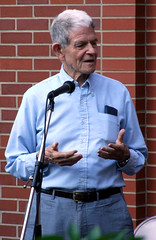 staughton4563 (Photo credit: stormbirdstudio)
staughton4563 (Photo credit: stormbirdstudio)be directed to "Reformers" of the Labor Movement.
in particular, building consensus among the rank and file as opposed to the current top-down
command structure, and inviting the surrounding community into partnership with our
organizations rather than the temporary event-focused invitations in vogue today.
we may not all agree on a particular strategy but if we cannot get to a point where we
all agree on its implementation, long-term success is doubtful.
support from our community is crucial to our success. but support is the end-result of a long-term
relationship. we cannot count on leaflets, You Tube videos, and Facebook pages to build
that relationship. Thanksgiving soup kitchens, and softball games for charity are a step in the right
direction but are lop-sided affairs where the message seems to be "see we're good guys, we give
you stuff" but asks and receives nothing from the community at large. loyalty cannot be purchased.
we need to invite non-unionized folk INTO our house,
the community should be inseparable from the movement
read on:
===========================O=================================
ZCommunications | A Letter To Other Occupiers by Staughton Lynd | ZNet Article:
"My fundamental concern is that the rhetoric of the Occupy Movement includes two propositions in tension with each other. We appear to say, on the one hand, that we must seek consensus, but on the other hand, that once a General Assembly is over individuals and grouplets are free to do their own thing."
===========================O=================================
===========================O=================================
We need to act within a wide strategic context, and engage in more than tactical exercises.
We need to invite local people to join our ranks and institutions. We cannot hope to win the trust of others, especially others different from ourselves in class background, cultural preferences, race, or gender, unless we stay long enough to win that trust one day at a time. We must be prepared to spend years in communities where there may not be many fellow radicals.
In thinking about our own lives, and how we can contribute over what Nicaraguans call a “long trajectory,” we need to acquire skills that poor and oppressed persons perceive to be needed.
We should understand consensus and nonviolence not as rigid rules, or as boundaries never to be crossed, but as a core or center from which our common actions radiate. Consensus is not just a style of conducting meetings. It seeks to avoid the common human tendency to say, after an action that runs into trouble, “I told you so.” The practice of consensus envisions that discussion should continue until every one in the circle is prepared to proceed with a group decision. Perhaps different ones of us have varying degrees of enthusiasm or even serious apprehensions. Anyone who has such misgivings should voice his or her concern because it may be an issue that needs to be addressed. But we must talk things out to a point where as a group we can say, “We are doing this together.”
Likewise nonviolence is under some circumstances the most promising way of challenging authority. Trotsky describes in his history of the Russian Revolution how, on International Women’s Day, 1917, hundreds of women in St. Petersburg left their work in textile factories demanding Peace and Bread. The women confronted the Cossacks, the policemen on horseback, in the streets. Unarmed, the women approached the riders, saying in effect: “We have the same interests you do. Our husbands and sons are no different from yourselves. Don’t ride us down!” And the Cossacks repeatedly refused to charge.
===========================O=================================
..
.ero
.












U7Hw~~60_57.JPG)
